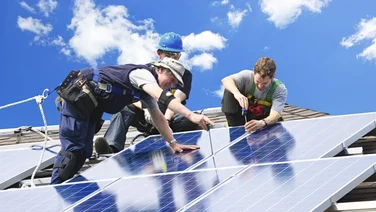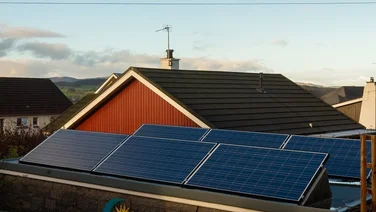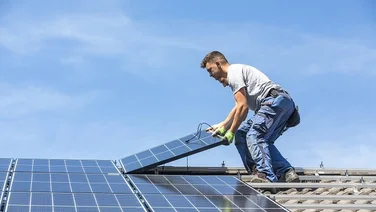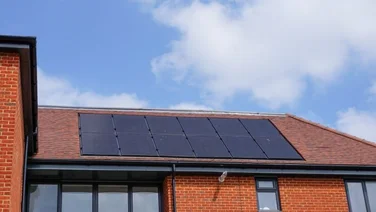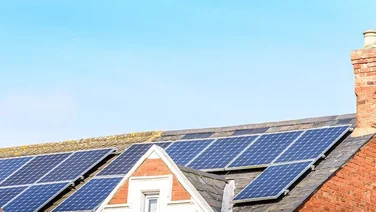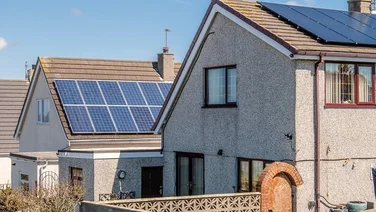- What's on this page?
- How much solar energy hits the earth every day?
- What is the world’s solar capacity?
- How much solar energy is consumed worldwide?
- What percentage of the world’s renewable energy is solar?
- What percentage of the UK’s renewable energy is solar?
- What is the UK’s solar capacity?
- How many solar panels are there in the UK?
- What is the best county in the UK for solar panels?
- Which country has the most solar panels?
- How many solar panels are there in China?
- Who is the largest producer of solar panels?
- What is the largest solar panel plant in the world?
- Attitudes towards solar panels
- The future of solar panels
- What next?
- FAQs
- Global solar capacity was just over 1.5 terawatt (TW) in 2023
- The UK’s solar capacity is now 15.7 GW
- Cornwall is the best UK county for solar, with roughly 26,600 solar installations
Over the past decade, solar energy has emerged as a viable, mainstream solution to climate change. Homeowners are installing them on their roofs, and businesses are investing as more and more people start to understand how solar panels work, and why they are such a sound investment.
As energy prices remain stubbornly high and climate change continues to worsen, there’s never been a better time to brush up on all things renewable – starting with solar.
In this article, we’ll reveal the world’s collective solar capacity, discuss the UK’s ever-improving solar credentials, and find out which area of the UK is best suited for solar panels.
Key solar panel statistics
- 1.5 million solar panel installations have been carried out across the UK, with just under 2% of the 28 million homes in the UK generating electricity from solar panels
- China provides around 80% of the world’s solar panels
- Solar doesn’t make up much of the UK’s energy mix. It accounted for only 6.8% of electricity generation in the last quarter of 2023
- The average amount of solar energy consumed per capita was 432 kWh during 2022.
- Solar panels cost roughly £7,026 for the average house
Where do you want to install solar panels?
Get startedWhat’s on this page?
How much solar energy hits the earth every day?
173,000 terawatts (TW) of solar energy strike the Earth at any given moment, according to physics professor Washington Taylor. This is more than 10,000 times the world’s total energy use during the same period of time.
To put this into perspective, the world’s population currently consumes roughly 23,900 terawatt-hours (TWh) of power each year – most of which is generated by fossil fuels.
What is the world’s solar capacity?
Solar capacity refers to the maximum output of an entity, such as a country or a solar farm. By the end of 2023, the global solar capacity was just over 1.5 terawatt (TW) – up 30% from the previous year. This growth pattern is expected to continue.
In fact, the International Energy Agency (IEA) suggests that global solar capacity will double by the end of 2028, becoming one of the largest power sources in the world.
Where do you want to install solar panels?
Get startedHow much solar energy is consumed worldwide?
According to Our World in Data, the average amount of solar energy consumed per capita was 432 kWh during 2022.
The figures for 2023 have not yet been released, but given the increase in global solar capacity over the past year, we can expect the 2023 figure to be a little higher.
The country that consumed the most solar energy per capita in 2022 was Australia – getting through 3,868 kWh – followed by the Netherlands, Japan, Israel, and Chile.
Focusing on the amount of energy consumed per capita, rather than cumulative consumption, is particularly useful when comparing countries. This means that the results won’t purely come down to the country’s size.
What percentage of the world’s renewable energy is solar?
According to the IEA, renewable energy accounted for 30% of global electricity generation in 2023– up from 28% in 2021.
During this time, solar energy accounted for around 5.4% of electricity generation, making it the third largest contributor. Hydropower accounted for 14.2% of electricity generation, and wind for 7.8%.
Data from the International Energy Agency (IEA)
As you can see, solar makes a substantial percentage of the global renewable energy mix. Plus, it’s set to lead the way in the renewable revolution. In fact, it grew the most out of all renewable energy types in 2023, according to the IEA.
What percentage of the UK’s renewable energy is solar?
As it stands, solar doesn’t make up much of the UK’s energy mix. It accounted for only 6.8% of electricity generation in the last quarter of 2023, according to the Government Energy Trends Report.
Although this figure is pretty low, solar capacity in the UK is increasing, with 1.1 GW added at the end of 2023 alone, the highest amount in six years, according to the government’s own reporting.
Renewables were also responsible for 44.5% of UK electricity generation in the last quarter of 2023.
Data from Government Energy Trends Report, December 2023
As you can see, the increase in solar capacity over 2023 has coincided with a increase in solar electricity generation. This isn’t always the case, however, since solar panels are weather dependent. Essentially, the more sun the UK gets in a year, the more electricity solar panels will generate.
Wind generation also increased in 2023, likely due to the large amount of storms the UK experienced towards the end of the year, since capacity hasn’t gone up by much.
The next few years will further shape the UK’s renewable sector.
The UK government has pledged to reach net zero emissions by 2050, and switching to renewable energy is the surest way to do that. But with the government failing to attract investment for new onshore wind farms in 2023, many research groups believe the UK might miss its 2050 deadline without more favourable policies towards renewables.
You might also like: 13 Solar Panel Facts.
What is the UK’s solar capacity?
As of January 2024, the UK’s total solar capacity stands at 15.7 GW, according to the government’s latest data, an increase of 6.6% compared to the previous year.
This is set to increase each year – with 58 MW of solar PV capacity being installed around the UK in January 2024 alone.
Domestic installations account for 29% of the UK’s total solar capacity, and made up 77% of the new capacity added in January 2024.
How many solar panels are there in the UK?
Although it’s pretty difficult to estimate the exact number of solar panels in the UK, the latest MCS data suggests there have been a little under 1.5 million solar panel installations carried out across the UK.
Of those, at least 519,409 were residential installations, meaning less than 2% of the 28 million homes in the UK are generating electricity from solar panels – a figure that will hopefully continue to increase as solar panel costs get more affordable in the coming years.
There are also currently around 1,170 solar farms operating in the UK, which provide clean energy to the Grid.
Ever wondered how many panels we’d need to power the whole country? According to Finder, we would need 29,690 km² of land to home our beloved panels. Compared to larger countries, this is pretty small – but due to the UK’s dainty size, this would take up 12% of our entire landmass.
What is the best county in the UK for solar panels?
Cornwall has been crowned the best county for solar. Home to roughly 26,600 solar panel installations (MCS, 2024), it is now one of the best-performing regions for renewable energy in the country.
For perspective, there are a total of 183,015 renewable energy sites in the south-west, and roughly 13% are located in Cornwall.
One of the main reasons why Cornwall is so good for solar is, of course, the weather. Put simply, there’s more sunshine for panels to absorb here, compared to solar panels in Scotland or northern England.
To give you an idea of how sunny Cornwall is, we’ve outlined just how much sunlight different UK regions receive on average in the chart below.
Whilst sunshine is key for solar panels, you want to make sure that they don’t overheat. According to manufacturers’ standards, 25°C is the optimum temperature for solar panels to operate.
Despite its sunny disposition, Cornwall typically experiences lower temperatures than other southern UK regions, as you can see on the graph below. This makes it the perfect location for panels.
Which country has the most solar panels?
China has the largest solar capacity in the world by a long shot. As of the end of 2023, it had around 600 GW of solar capacity.
By contrast, the US, the next runner-up, has only US only having 161 GW of installed capacity.China’s growth in the solar industry has been phenomenal.
In 2023 alone, it added 216 GW’s worth of capacity, commissioning as much solar PV in that year as the entire world did in 2023.
It doesn’t stop there, either. As well as generating all this power domestically, China provides around 80% of the world’s solar panels.
For more on how China came to dominate the solar industry, check out our analysis.
How many solar panels are there in China?
The short answer: a lot. In just 25 years, China has gone from having virtually no solar panels to having the biggest capacity out of any country.
What’s even more impressive is how creatively the country has implemented its solar plants. For example, its boldest solar plant, Dezhou Dingzhuang Solar Farm, is the world’s largest floating marine solar farm. Situated in the northwestern province of Shandong, this solar farm holds a capacity of roughly 320 MW worth of solar panels on a lake.
China is even getting creative with the placement of its panels on land, too. If you fly over Datong County, you’ll see two giant pandas constructed from thousands of solar panels. And to think, some people complain about how solar panels look.
To put China’s growth into perspective, check out the aerial view of one of its largest solar power plants, Longyangxia solar park – its four million solar panels cover a massive 27 square kilometres (10 square miles) of Qinghai province:
Although the aerial view shows how much the plant has grown, it doesn’t quite emphasise how large it is. The first photo was taken in April 2013, when the plant had just started development, whereas the second was taken in January 2017. Its four million solar panels cover a massive 27 square kilometers (10 square miles) of Qinghai province.
Who is the largest producer of solar panels?
Since China dominates the solar industry, it’s not surprising that it’s home to most of the biggest and best solar panel manufacturers.
Below, we’ve listed the top 10 solar manufacturers in the world.
Rank | Company | Headquarters | 2022 shipment capacity (GW) |
|---|---|---|---|
5 | Jinko Solar | China | 30.8 |
7 | Trina Solar | China | 27 |
4 | LONGi Solar | China | 26.6 |
2 | JA Solar | China | 24 |
6 | Canadian Solar | Canada | 14.3 |
1 | Tongwei Solar | China | 8-9 |
3 | Risen Energy | China | 8-9 |
8 | DAS Solar | China | Not specified |
10 | First Solar | USA | 5.3 |
Data from The National Renewable Energy Laboratory’s Fall 2023 Solar Industry Update
These manufacturers shipped out the most solar panels in the first half of 2023.
The top manufacturers of solar cells include Tongwei and Aiko, both Chinese companies.
You can find more information about the top seven largest solar panel manufacturers by going to our page.
What is the largest solar panel plant in the world?
China takes the top spot again in this category. Golmud Solar Park, located in the Qinghai Province, is the world’s largest solar panel plant. It has nearly seven million solar panels, with a capacity of 2.8 GW.
But it might not be at the top spot for much longer. The Datong solar farm in Xinjiang, which so far has a capacity of 1 GW, is set to grow to 3 GW when the final two phases of the project are completed.
Check out the 10 largest solar panels in the world in the table below:
Rank | Solar park | Location | Size (GW) |
|---|---|---|---|
1 | Goldmud Solar Park | China | 2.8 |
2 | Bhalda Solar Park | India | 2.7 |
3 | Pavagada Solar Park | India | 2.05 |
4 | Mohammed bin Rashid Al Maktoum Solar Park | UAE | 1.63 |
5 | Benban Solar Park | Egypt | 1.61 |
6 | Tengger Desert Solar Park | China | 1.51 |
7 | Noor Abu Dhabi Solar Power Project | Abu Dhabi | 1.17 |
9 | Jinchuan Solar Park | China | 1.03 |
8 | Datong Solar Power Top Runner Base | China | 1 (and counting) |
10 | NP Kunta Ultra Mega Solar Park | India | 1 |
Attitudes towards solar panels
More homeowners are considering buying solar panels to reduce both their energy bills and their carbon footprints.
In our most recent National Home Energy Survey, we found that 85% of respondents knew what solar panels are, and 69% would buy or rent a property that had solar panels installed (up from 65% last year).
We also found that opinions on solar panels aligned with age. A staggering 74% of Gen Z said they were likely to purchase a property with solar panels.
The numbers were slightly lower (but still favourable) for the Silent Generation and Baby Boomers, 61% and 65% of which, respectively, would purchase a property with solar panels.
Interestingly, only 5% of respondents actually purchased solar panels in the past 12 months.
So what’s holding people back? Like many things in life, it comes down to money. Solar panels cost roughly £7,026 for the average house, which is more than what a lot of people can afford.
In our survey, roughly half of respondents said they would purchase solar panels themselves if money wasn’t an issue, whilst 43% said high energy bills prevented them from buying green tech in general.
On the bright side though 47% of respondents did say they acquired one piece of low-carbon tech in the past year, with cheaper products such as smart metres and smart appliances being the most commonly purchased.
The future of solar panels
The future of solar panels looks promising, with the IEA expecting solar capacity to double by 2028, reaching just under 3.9 TW.
It expects solar and wind to account 95% of new renewable energy additions, with solar generating more electricity than nuclear by 2026.
By 2028, solar is expect to account for over 12% of electricity generation, more than double what it accounts for today.
China is expected to account for 60% of renewable energy growth from now until 2028, largely thanks to new wind and solar additions.
In the UK, some experts suggest that solar energy could account for as much as 20% of the UK’s total electricity generation by 2030.
What next?
Want to hop on the solar panel bandwagon? Check out our page on Solar Panel Costs to figure out what type of panels will suit you and your family.
Want to speed up the process? Try comparing solar panel quotes by simply popping a few details in this short form. Once we receive your information, we’ll connect you with our solar panel experts, who will soon be in touch with an array of solar panel quotes to choose from.
FAQs
What percentage of the UK has solar panels?
More than 1.5 million solar panel installations have been carried out across the UK, according to the latest MCS data – meaning under 2% of the 28 million homes in the UK are generating electricity from solar panels.
And as time goes by, solar panels are only going to become more popular. We only need to look at the past decade to see the potential of this green tech, and how fast its popularity can grow.
In 2008, solar panels accounted for just one megawatt of electricity generation in England – including the Isle of Wight – compared to 11,730 megawatts by 2020.
Want to learn more? Check out our useful page: How Many People Have Solar Panels in the UK?
How efficient will solar panels be in 2030?
Most solar panels on the market today have an efficiency rating of 15-20%, but can reach up to 22% if you’re willing to splash out.
Some experts in the industry estimate that silicon module efficiency will begin to approach 25% across much of the industry by 2030. This might not seem like much of an improvement, but a little goes a long way when it comes to solar panel efficiency.

